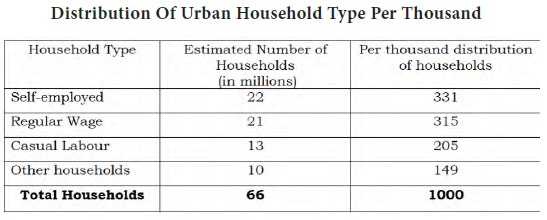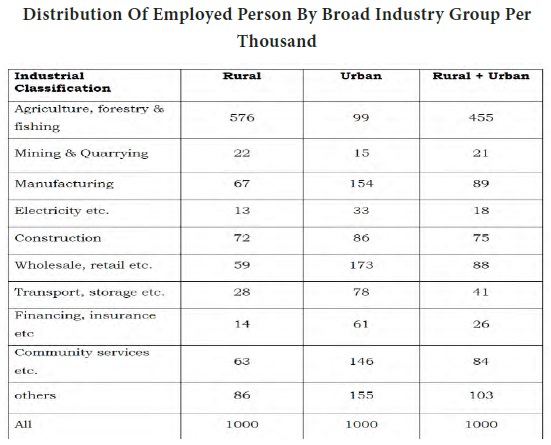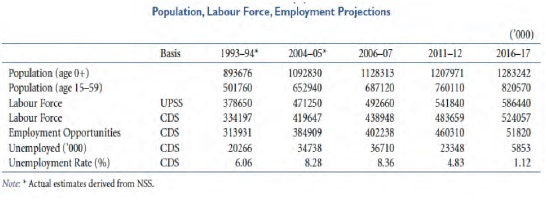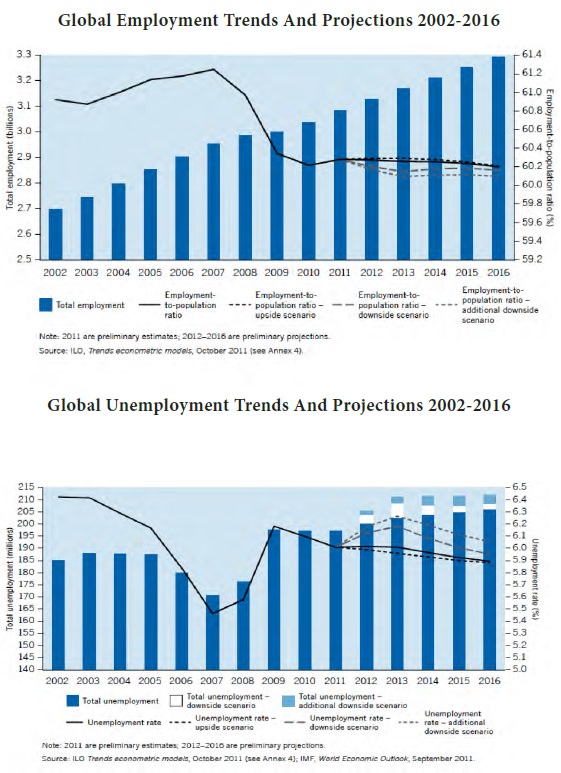Managerial Economics - Employment And Unemployment In India
Types Of Unemployment - Employment And Unemployment In India
Posted On :
Frictional unemployment: unemployment that occurs naturally during the normal working of an economy.
Types Of Unemployment
1. Frictional unemployment: unemployment that occurs naturally during the normal working of an economy. Temporarily caused by inefficient movement of people between regions and jobs, as it takes time for new workers to search and decide for a job. voluntary switching of jobs, fired or seeking re employment
2. Structural unemployment: The change in industrial structure of a country, change in Demand and technology ,change in requirement of skills. Mismatch between demand and supply.
3. Cyclical unemployment: unemployment is more at a particular time that is due to economic recession, depression and others.
4. Technological unemployment: due to change in technology, new production and process leads to reduction in work requirement.
5. Seasonal unemployment: in some industries the work cannot be there through out the years as it is seasonal in nature.
6. Disguised unemployment: lack of work of the type which would fully utilize the degree of skill possessed by the workers.
Various categories like, ‘workers’, ‘unemployed’, ‘labour force’, ‘out of labour force’ are as explained below:
(a) Workers (or employed): Persons who are engaged in any economic activity or who, despite their attachment to economic activity, have abstained from work for reasons of illness, injury or other physical disability, bad weather, festivals, social or religious functions or other contingencies necessitating temporary absence from work constitute workers. Unpaid helpers who assist in the operation of an economic activity in the household, farm or non-farm activities are also considered as workers. All the workers are assigned one of the detailed activity status under the broad activity category 'working or being engaged in economic activity'.
(b) Seeking or available for work (or unemployed): Persons, who, owing to lack of work, had not worked but either sought work through employment exchanges, intermediaries, friends or relatives or by making applications to prospective employers or expressed their willingness or availability for work under the prevailing condition of work and remuneration are considered as those who are ‘seeking or available for work’ (or unemployed).
(c) Labour force: Persons who are either 'working' (or employed) or 'seeking or available for work' (or unemployed) during the reference period together constitute the labour force.
(d) Out of labour force: Persons who are neither 'working' and at the same time nor 'seeking or available for work' for various reasons during the reference period are considered to be 'out of labour force'. The persons under this category are students, those engaged in domestic duties, renters, pensioners, recipients of remittances, those living on alms, infirm or disabled persons, too young or too old persons, prostitutes, etc.
1. Frictional unemployment: unemployment that occurs naturally during the normal working of an economy. Temporarily caused by inefficient movement of people between regions and jobs, as it takes time for new workers to search and decide for a job. voluntary switching of jobs, fired or seeking re employment
2. Structural unemployment: The change in industrial structure of a country, change in Demand and technology ,change in requirement of skills. Mismatch between demand and supply.
3. Cyclical unemployment: unemployment is more at a particular time that is due to economic recession, depression and others.
4. Technological unemployment: due to change in technology, new production and process leads to reduction in work requirement.
5. Seasonal unemployment: in some industries the work cannot be there through out the years as it is seasonal in nature.
6. Disguised unemployment: lack of work of the type which would fully utilize the degree of skill possessed by the workers.
Various categories like, ‘workers’, ‘unemployed’, ‘labour force’, ‘out of labour force’ are as explained below:
(a) Workers (or employed): Persons who are engaged in any economic activity or who, despite their attachment to economic activity, have abstained from work for reasons of illness, injury or other physical disability, bad weather, festivals, social or religious functions or other contingencies necessitating temporary absence from work constitute workers. Unpaid helpers who assist in the operation of an economic activity in the household, farm or non-farm activities are also considered as workers. All the workers are assigned one of the detailed activity status under the broad activity category 'working or being engaged in economic activity'.
(b) Seeking or available for work (or unemployed): Persons, who, owing to lack of work, had not worked but either sought work through employment exchanges, intermediaries, friends or relatives or by making applications to prospective employers or expressed their willingness or availability for work under the prevailing condition of work and remuneration are considered as those who are ‘seeking or available for work’ (or unemployed).
(c) Labour force: Persons who are either 'working' (or employed) or 'seeking or available for work' (or unemployed) during the reference period together constitute the labour force.
(d) Out of labour force: Persons who are neither 'working' and at the same time nor 'seeking or available for work' for various reasons during the reference period are considered to be 'out of labour force'. The persons under this category are students, those engaged in domestic duties, renters, pensioners, recipients of remittances, those living on alms, infirm or disabled persons, too young or too old persons, prostitutes, etc.
Workers have been further
categorized as self-employed, regular salaried/wage employee and casual wage
labourers. These categories are defined in the following paragraphs.
Self-Employed:
Persons who operate their own farm or non-farm enterprises or are engaged independently in a profession or trade on own-account or with one or a few partners are self-employed in household enterprises. The essential feature of the self-employed is that they have autonomy (i.e., regarding how, where and when to produce) and economic independence (i.e., regarding market, scale of operation and money) for carrying out operation. The fee or remuneration received by them consists of two parts - the share of their labour and profit of the enterprise. In other words, their remuneration is determined wholly or mainly by sales or profits of the goods or services which are produced by themselves. The Indian scenario is given below.

The distribution of employed persons under various broad Industry group is given in the following table. Around 50% of the population are engaged in the primary sectors like agriculture, forestry and fisheries followed by manufacturing and wholesale, retail business. Construction industry and retail business are booming in our country and also provides more employment opportunities in the urban areas. High risk jobs like mining, financing etc.,do not create much employment.

From the following table on population, labour force, employment projections in India for the year 2016- 2017 it is observed that the population in the age group of 15-59 is growing along with the total population. The forecast says the employment opportunities to be created in 2016-17 will more. On the other hand the unemployment rate is going to be reduced to 1.12% from 6.06 %. The global trend for the same year is also discussed below.

The following two graphs on
employment and unemployment projections for 2016 explains clearly that the
total employment opportunities created by the world is going to grow from 3 %
in 2002 to 61% in 2016. But on the other hand the employment to population
ratio is declining. Due to this decline unemployment rate is growing.
Understanding the world trend and the Indian scenario will help managers take
various decisions

Self-Employed:
Persons who operate their own farm or non-farm enterprises or are engaged independently in a profession or trade on own-account or with one or a few partners are self-employed in household enterprises. The essential feature of the self-employed is that they have autonomy (i.e., regarding how, where and when to produce) and economic independence (i.e., regarding market, scale of operation and money) for carrying out operation. The fee or remuneration received by them consists of two parts - the share of their labour and profit of the enterprise. In other words, their remuneration is determined wholly or mainly by sales or profits of the goods or services which are produced by themselves. The Indian scenario is given below.

The distribution of employed persons under various broad Industry group is given in the following table. Around 50% of the population are engaged in the primary sectors like agriculture, forestry and fisheries followed by manufacturing and wholesale, retail business. Construction industry and retail business are booming in our country and also provides more employment opportunities in the urban areas. High risk jobs like mining, financing etc.,do not create much employment.

From the following table on population, labour force, employment projections in India for the year 2016- 2017 it is observed that the population in the age group of 15-59 is growing along with the total population. The forecast says the employment opportunities to be created in 2016-17 will more. On the other hand the unemployment rate is going to be reduced to 1.12% from 6.06 %. The global trend for the same year is also discussed below.


Tags : Managerial Economics - Employment And Unemployment In India
Last 30 days 467 views












